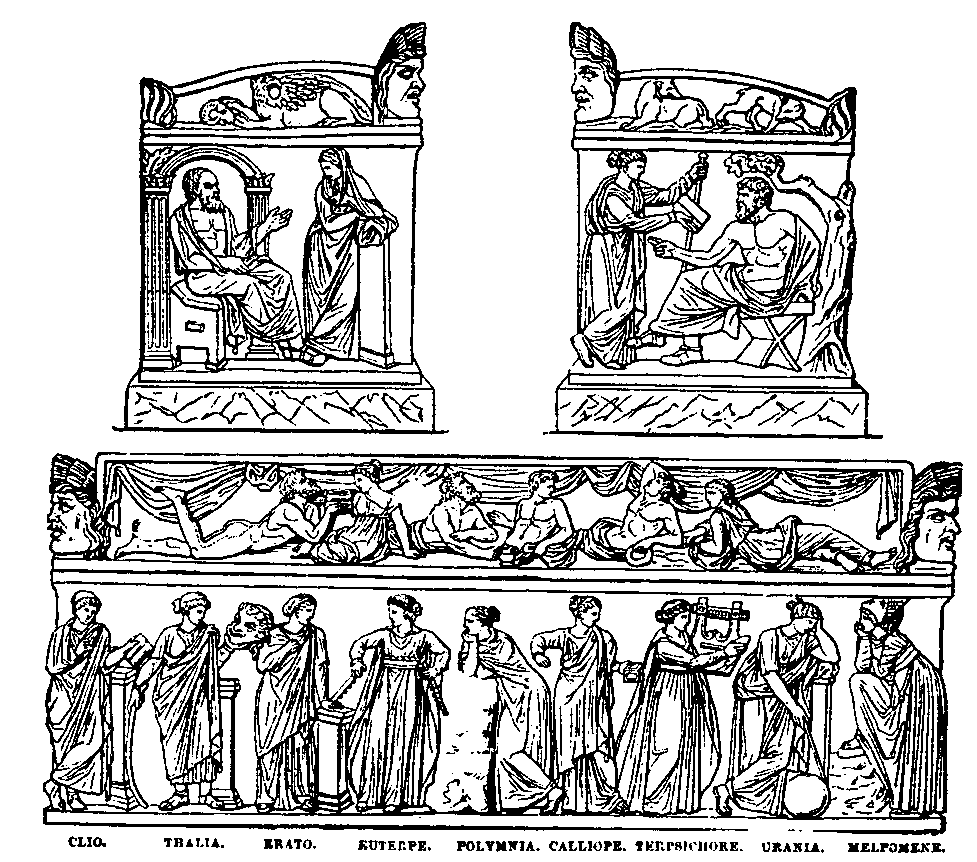| MUSES |
Deprecated: Function split() is deprecated in /www/www-ccat/data/classics/myth/php/tools/dictionary.php on line 64
In Greek mythology originally the Nymphs of inspiring springs, then goddesses of song in general, afterwards the representatives of the various kinds of poetry, arts, and sciences. In Homer, who now speaks of one, and now of many Muses, but without specifying their number or their names, they are considered as goddesses dwelling in Olympus, who at the meals of the gods sing sweetly to the lyre of Apollo, inspire the poet and prompt his song. Hesiod [Theog. 52-,76-,] calls them the nine daughters of Zeus and Mnemosyne, born in Pieria, and mentions their names, to which we shall at the same time add the province and the attributes afterwards assigned to each (see cuts). (1) CALLIOPE (she of the fair voice), in Hesiod the noblest of all, the Muse of epic song; among her attributes are a wax tablet and a pencil. (2) CLIO (she that extols), the Muse of history; with a scroll. (3) EUTERPE (she that gladdens), the Muse of lyric song; with the double flute. (4) THALIA (she that flourishes), the Muse of comedy and bucolic poetry; with the comic mask, the ivy wreath, and the shepherd's staff. (5) MELPOMENE (she that sings), the Muse of tragedy; with tragic mask, ivy wreath, and occasionally with attributes of individual heroes, e.g. the club, the sword. (6) TERPSICHORE (she that rejoices in the dance), the Muse of dancing; with the lyre. (7) ERATO (the lovely one), the Muse of erotic poetry; with a smaller lyre. (8) POLYMNIA or POLYHYMNIA (she that is rich in hymns), the Muse of serious sacred songs; usually represented as veiled and pensive. (9) URANIA (the heavenly), the Muse of astronomy; with the celestial globe. Three older Muses were sometimes distinguished from these. MELETE (Meditation), MNEME (Remembrance), AOIDE (Song), whose worship was said to have been introduced by Aloidae, Otus and Ephialtes, near Mount Helicon. Thracian settlers, in the Pierian district at the foot of Olympus and of Helicon in Boeotia are usually mentioned as the original founders of this worship. At both these places were their oldest sanctuaries. According to the general belief, the favourite haunts of the Muses were certain springs, near which temples and statues had been erected in their honour: Castalia, at the foot of Mount Parnassus, and Aganippe and Hippocrene, on Helicon, near the towns of Ascra and Thespiae. After the decline of Ascra, the inhabitants of Thespiae attended to the worship of the Muses and to the arrangements for the musical contests in their honour that took place once in five years. They were also adored in many otherplaces in Greece. Thus the Athenians offered them sacrifices in the schools, while the Spartans did so before battle. As the inspiring Nymphs of springs they were early connected with Dionysus; the god of poets, Apollo, is looked on as their leader (Musagetes), with whom they share the knowledge of past, present, and future. As beings that gladden men and gods with their song, Hesiod describes them as dwelling on Olympus along with the Charites and Himeros. They were represented in art as virgin goddesses with long garments of many folds, and frequently with a cloak besides; they were not distingnished by special attributes till comparatively later times. The Roman poets identified them with the Italian Camence, prophetic Nymphs of springs and goddesses of birth, who had a grove at Rome outside the Porta Capena. (See EGERIA .) The Greeks gave the title of Muses to their nine most distinguished poetesses: Praxilla, Mcero, Anyte, Erinna, Te1esilla, Corinna, Nossis, Myrtis, and Sappho. |
|
|
Pictures and Media
|
|
THE MUSES. (Sacroobagus in the Louvre, Paris.) |

|
|
